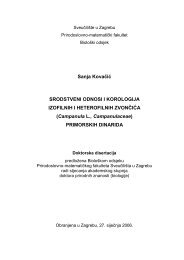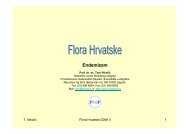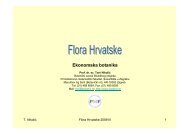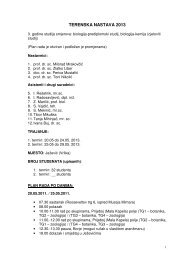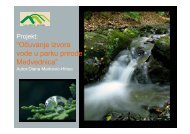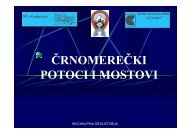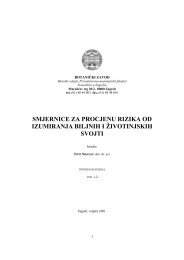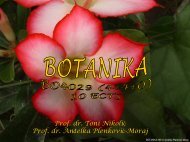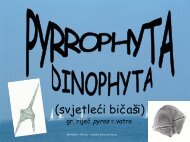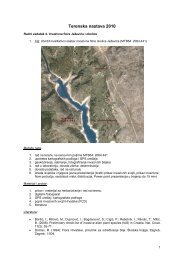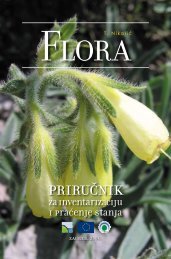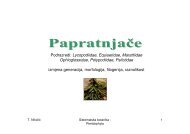important plant areas in central and eastern europe - hirc.botanic.hr ...
important plant areas in central and eastern europe - hirc.botanic.hr ...
important plant areas in central and eastern europe - hirc.botanic.hr ...
You also want an ePaper? Increase the reach of your titles
YUMPU automatically turns print PDFs into web optimized ePapers that Google loves.
MethodologyBRANO MOLNARBRANO MOLNARCrocus heuffelianus (left) <strong>and</strong> Iris pumilaEndemics, near endemic/limited range speciesFor the purposes of this project, an ‘endemic species’ is def<strong>in</strong>ed as a species that occurs<strong>in</strong> only one country, <strong>and</strong> a ‘near endemic’ or ‘limited range species’ is def<strong>in</strong>ed as a‘species which occur <strong>in</strong> limited numbers <strong>in</strong> no more than 3 countries’.There are 246 Criterion Aiii <strong>and</strong> Aiv species (t<strong>hr</strong>eatened endemics <strong>and</strong> nearendemic/limited range species) <strong>in</strong> the 7 partner countries, which are not currentlyrecognised on any global or regional Red Lists or European species protectionlegislation.Criterion B: <strong>botanic</strong>al richnessThis methodology for apply<strong>in</strong>g this criterion was based on a comparison of speciesrichness with<strong>in</strong> st<strong>and</strong>ard units of habitat classification. For this project, EUNIS level 2habitats, were used as the unit of comparison. For example E5 ‘Dry Grassl<strong>and</strong>s’ werecompared for species richness, <strong>and</strong> D1 ‘Raised & Blanket Bogs’ were compared forspecies richness. Each country def<strong>in</strong>ed the <strong>in</strong>dicator species to use for comparisons ofrichness. Indicators species could <strong>in</strong>clude all characteristic species for that habitat, orcould be targeted towards t<strong>hr</strong>eatened, rare or endemic species, or could focus onparticular taxonomic groups, such as mosses, lichens, fungi or algae. Details of thenational <strong>in</strong>dicator lists can be found <strong>in</strong> the seven national publications. Detaileddiscussion on the application of this criterion <strong>in</strong> Europe can be found <strong>in</strong> the technicalreport of national <strong>and</strong> the regional workshops held between 2001 <strong>and</strong> 2004.Criterion C: t<strong>hr</strong>eatened habitatsThere were 194 t<strong>hr</strong>eatened habitats <strong>in</strong> the Criterion C lists for the seven partnercountries. The list of t<strong>hr</strong>eatened habitats was taken from the EU Habitats DirectiveAnnex I, <strong>and</strong> the Bern Convention Resolution 4 list of habitats. The criterion was split<strong>in</strong>to two categories Ci <strong>and</strong> Cii, where Ci are ‘priority t<strong>hr</strong>eatened habitats’ as def<strong>in</strong>ed <strong>in</strong>the EU Habitats Directive.There were 42 Ci (priority t<strong>hr</strong>eatened habitats) <strong>and</strong> 152 Cii(t<strong>hr</strong>eatened habitats)17



